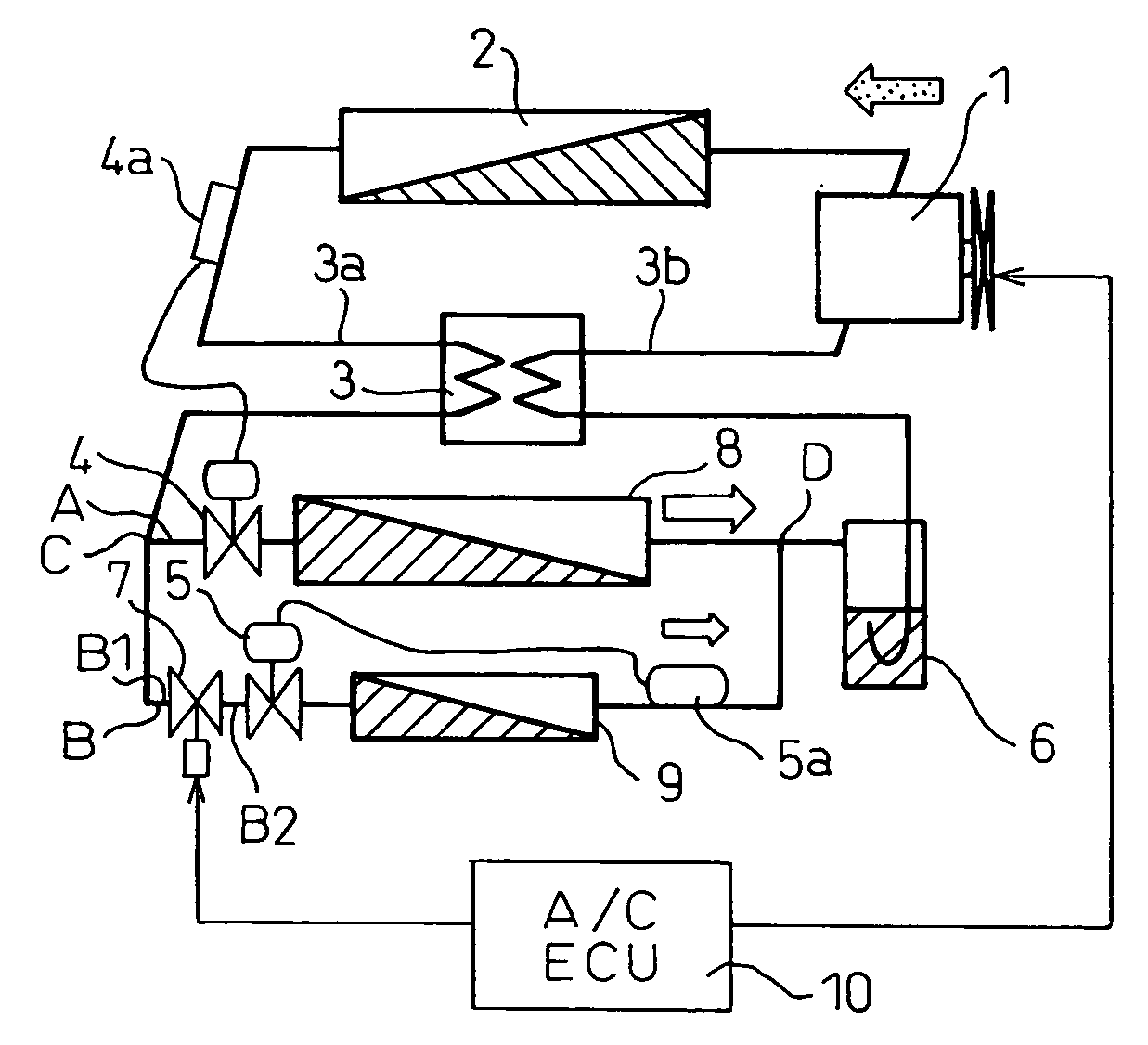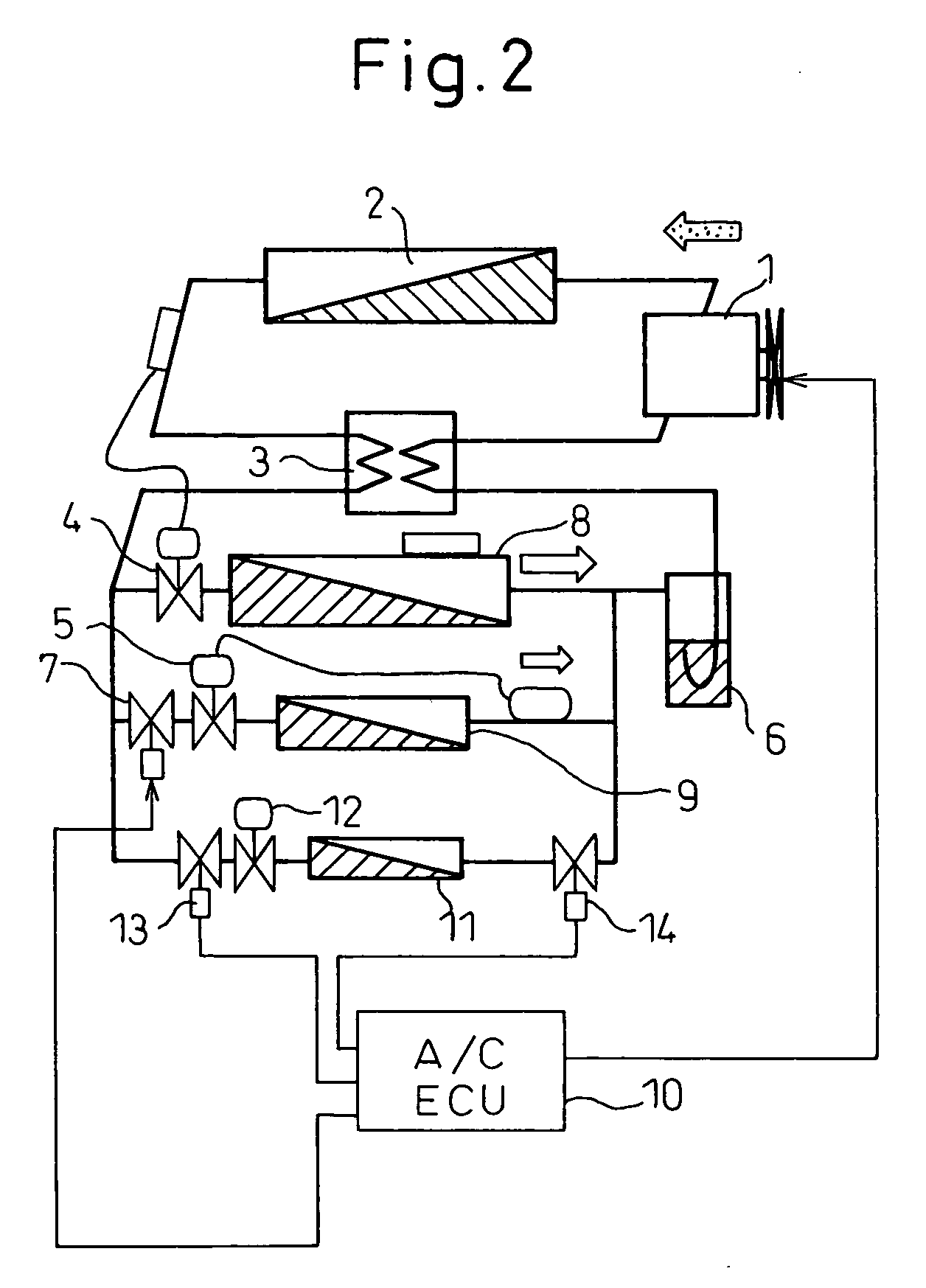Refrigerating cycle
a technology of refrigerating cycle and hammer, which is applied in the direction of refrigeration components, transportation and packaging, light and heating equipment, etc., can solve the problems of further affecting the effect of rushing noise and noise, and achieve the effect of reducing rushing noise or water hammer noise, easing inflow, and reducing unpleasant nois
- Summary
- Abstract
- Description
- Claims
- Application Information
AI Technical Summary
Benefits of technology
Problems solved by technology
Method used
Image
Examples
first embodiment
[0026]FIG. 1 is a view of the configuration of a refrigeration cycle for vehicle air-conditioning showing a first embodiment of the present invention. This refrigeration cycle uses a refrigerant comprised of CO2 having a high pressure of the critical pressure or more (supercritical state). Therefore, this refrigeration cycle forms a supercritical refrigeration cycle.
[0027] A compressor 1 obtains drive power from a not shown vehicle engine through an electromagnetic clutch (not shown) to suck in and compress the refrigerant. Note that the compressor 1 may be any of a fixed capacity type compressor operating continuously by operation of an electromagnetic clutch or a variable capacity type compressor able to be changed in discharge capacity.
[0028] A discharge side of the compressor 1 is provided with a radiator 2 forming an outside unit. This radiator 2 exchanges heat between a discharged refrigerant in the high temperature, high pressure supercritical state discharged from the comp...
second embodiment
[0057] Next, a second embodiment according to the present invention will be explained with reference to FIG. 2. The second embodiment adds to the first embodiment a set of solenoid valves (two, for inlet and outlet), a pressure reducer, and an evaporator. For this reason, the second embodiment will be explained focusing on the locations different from the first embodiment.
[0058] Reference numeral 11 indicates a vehicle refrigerator evaporator (hereinafter referred to as the “third evaporator”). Reference numeral 13 indicates a third evaporator inlet solenoid valve, while 14 indicates a third evaporator outlet solenoid valve. Normally, the two solenoid valves of 13 and 14 are simultaneously turned on and off. Reference numeral 12 indicates a third pressure reducer.
[0059] If suddenly operating the third evaporator while the first evaporator is operating, rushing noise is generated in the third pressure reducer 12. The second embodiment can be configured by reading the “third” in the...
third embodiment
[0063] Instead of the second pressure reducer 5 of the first embodiment, it is also possible to employ a pressure reducer having a variable aperture function. This pressure reducer gradually changes the cross-sectional area of the flow channel of the refrigerant to the second evaporator 9. This type of slow change can be provided by the response characteristics of the variable aperture or by the control unit 10 for controlling the actuator for driving the variable aperture. The second pressure reducer 5 has a variable aperture for opening or closing the flow of refrigerant to the second evaporator 9. When starting or stopping the second evaporator 9 while the first evaporator 8 is operating, it gradually opens or closes the variable aperture. By gradually opening or closing the variable aperture, the refrigerant smoothly flows or is cut off and the rushing noise or water hammer noise can be reduced. A pressure reducer with such a variable aperture function can be employed in additio...
PUM
 Login to View More
Login to View More Abstract
Description
Claims
Application Information
 Login to View More
Login to View More - R&D
- Intellectual Property
- Life Sciences
- Materials
- Tech Scout
- Unparalleled Data Quality
- Higher Quality Content
- 60% Fewer Hallucinations
Browse by: Latest US Patents, China's latest patents, Technical Efficacy Thesaurus, Application Domain, Technology Topic, Popular Technical Reports.
© 2025 PatSnap. All rights reserved.Legal|Privacy policy|Modern Slavery Act Transparency Statement|Sitemap|About US| Contact US: help@patsnap.com



